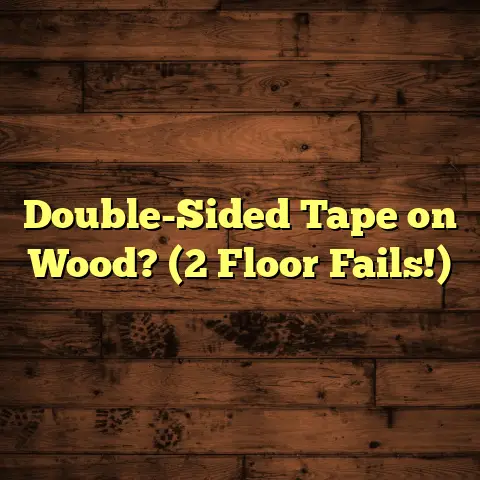Best Hardwood Flooring Liquidators: Where To Find Deals? (Explained)
Finding the best deals on hardwood flooring is like embarking on a treasure hunt. It can be exhilarating, and at times, it can feel overwhelming. With so many options and sources available, it’s essential to know where to look for the best bargains. I’ve navigated through the world of hardwood flooring liquidators over the years, and I’m here to share my insights, experiences, and tips to help you find those hidden gems.
My Journey with Hardwood Flooring Liquidators
When I first started my flooring business, I was eager but inexperienced. I remember my first significant project—my client wanted a stunning oak floor but was constrained by a tight budget. It was a challenge that pushed me to think creatively. I had to find a way to deliver quality without breaking the bank. That’s when I stumbled upon hardwood flooring liquidators.
What Are Hardwood Flooring Liquidators?
Hardwood flooring liquidators are companies that specialize in selling surplus or discontinued flooring products at discounted prices. They often acquire stock from manufacturers that have overproduced or need to clear out inventory. This means you can find high-quality materials for a fraction of the original cost.
Initially, I thought all liquidators were the same, but that’s where I was mistaken. Some focus on high-end products, while others cater to more budget-friendly options. This variety opened up a world of possibilities for my clients and me.
During my early days, I made mistakes and learned valuable lessons about what to look for in a liquidator. It’s not just about price; quality and customer service play crucial roles too.
Where to Find Deals
Over the years, I’ve scoured various outlets for the best deals on hardwood flooring. Here are some of my favorite go-to places:
Local Liquidators
Visiting local flooring liquidators can be a game-changer. I’ve found gems hidden in these stores that aren’t available online. Plus, you get to inspect the flooring firsthand, which is critical for assessing quality.
Tip: Bring a measuring tape! You never know when you might stumble upon an amazing deal on a large quantity of flooring that could be perfect for your next project.
I remember one particular visit to a local liquidator where I found a batch of reclaimed wood that had a rich history. Each plank had its own story, and my client was thrilled to use such unique materials in their home. It was a win-win situation: they got an incredible floor, and I secured a great deal.
Online Marketplaces
Websites like eBay and Craigslist can have unexpected finds, especially if you’re willing to pick up items yourself. I once bought a large batch of engineered hardwood from a seller who needed it gone quickly. By acting fast and negotiating, I saved hundreds.
Online marketplaces can be hit or miss, but if you’re patient and vigilant, you might find the perfect flooring at an unbeatable price. Just make sure to ask for detailed pictures and descriptions before finalizing any deals.
Manufacturer Direct Sales
Some manufacturers hold liquidation sales or offer direct sales on their websites. Signing up for newsletters can keep you informed about any upcoming sales. For example, I once scored a fantastic deal on maple flooring directly from a manufacturer clearing out their stock.
These manufacturer sales often include excellent warranties or guarantees, providing an extra layer of security for your investment.
Auctions
Don’t overlook auctions! Sometimes, flooring companies will auction off excess inventory. It can be hit or miss, but if you do your homework and know what you’re looking for, it’s possible to snag a great deal.
I once attended an auction where several lots of hardwood flooring were available. It was thrilling to bid against others, and I ended up winning high-quality flooring at a fraction of the retail price.
The Role of FloorTally in Cost Estimation
In my experience as a flooring contractor, precise cost estimation is crucial. That’s where FloorTally comes into play for me. This tool has saved me countless hours and headaches in estimating costs, especially when dealing with liquidated materials.
How FloorTally Works
- Accurate Cost Estimates: FloorTally pulls local material and labor rates to provide realistic budgets right off the bat. This transparency builds trust with my clients.
- Customizable Options: The platform allows me to showcase different flooring styles tailored to my client’s needs, streamlining their decision-making process.
- Comprehensive Project Planning: Inputting multiple room dimensions and types into FloorTally ensures no detail is overlooked.
- Effective Waste Management: It accounts for potential waste in calculations, helping to minimize unexpected costs.
- User-Friendly Interface: Whether I’m working with clients or subcontractors, everyone can navigate the platform easily.
Using FloorTally not only enhances my workflow but also allows me to focus on what really matters: delivering exceptional flooring installations.
Challenges I Faced
While finding great deals is thrilling, it’s not always smooth sailing. One of my most challenging experiences involved a shipment of flooring that looked perfect on paper but fell short in quality when I received it.
Quality Control Issues
I purchased some beautiful walnut planks from an online auction, thinking I got a steal. However, upon arrival, many of the planks were damaged or warped. This taught me the importance of inspecting materials whenever possible and asking questions before purchasing.
Lesson Learned: Always verify the return policy and understand what you’re getting into before committing to an online purchase.
Timing Considerations
Timing can also be tricky when dealing with liquidators. I remember waiting too long to buy a batch of hickory flooring that was perfect for a client’s renovation project. By the time I acted, someone else had snatched it up.
Advice: If you find something that fits your project perfectly, don’t hesitate!
Comparing Options
After trying out different liquidators over the years, I’ve developed a preference for certain types based on specific needs:
Big-Box Stores vs. Local Liquidators
Big-box stores often have lower prices but lack the variety and unique finds you might discover at local liquidators. For instance, while shopping at Home Depot, I found standard oak flooring at reasonable prices but nothing special or unique.
On the other hand, visiting a local liquidator led me to discover rare reclaimed wood that added character to a client’s home renovation project.
Online vs. In-Person Shopping
Online shopping for flooring can be convenient but lacks the tactile experience of seeing and feeling the product in person. While I’ve scored great deals online, nothing beats walking through a liquidator’s warehouse and discovering hidden treasures.
Practical Tips for Shopping
Based on my experiences, here are some practical tips to make your shopping experience smoother:
- Do Your Research: Know what you’re looking for in terms of style and price point before heading out or logging on.
- Be Prepared to Negotiate: Many liquidators are open to negotiation, especially if you’re buying in bulk.
- Check Reviews: Look for reviews or testimonials about liquidators you’re considering. This helps avoid potential pitfalls.
- Stay Flexible: Be open to different styles or materials than initially planned; you might find something better suited to your project.
- Keep Track of Measurements: Always measure your spaces accurately and keep those notes handy when shopping.
Understanding Flooring Types
While hardwood is often the star of the show in flooring discussions, knowing about different types can help you make informed decisions during your search:
Solid Hardwood
Solid hardwood is milled from a single piece of wood and is renowned for its durability and timeless appeal. It’s also relatively easy to refinish multiple times throughout its life span.
In one project, I dealt with solid oak hardwood from a local liquidator that had been reclaimed from an old barn. The character it brought into the home was unparalleled!
Engineered Hardwood
Engineered hardwood consists of multiple layers of wood veneer glued together over a plywood base. This type is more resistant to moisture and temperature changes compared to solid hardwood.
While working on a high-humidity project near the beach, engineered hardwood proved invaluable as it maintained its integrity despite environmental challenges.
Reclaimed Wood
Reclaimed wood has been repurposed from previous structures—think barns or old factories—which adds history and character to any space. Sourcing reclaimed wood can be tricky but rewarding if done correctly.
I recall one client who wanted their new home infused with charm; we sourced reclaimed wood from an old church that had been decommissioned. The results were stunning!
Laminate vs. Vinyl
While not hardwood per se, laminate and vinyl are often considered alternatives due to their affordability and ease of installation. Laminate mimics wood appearance while being more resistant to scratches and moisture compared to traditional hardwood floors.
During one budget-conscious renovation project, we opted for laminate after thorough discussions with our clients about their lifestyle needs—resulting in happy clients who loved the look without breaking the bank!
Installation Process
Once you’ve secured your flooring materials, understanding the installation process is crucial:
Preparation
Before installation begins, ensure that your subfloor is clean and dry; this sets the stage for successful installation. If you’re working with floating floors like laminate or engineered hardwood, ensure there’s enough room around the edges for expansion.
Acclimation
Allowing your hardwood flooring to acclimate in your home for several days helps prevent issues with warping or buckling later on due to humidity changes.
Installation Methods
There are various installation methods depending on your chosen material:
- Nail Down: Commonly used for solid hardwood floors; nails secure boards directly into the subfloor.
- Glue Down: Often used for engineered hardwood; adhesive bonds planks directly onto the subfloor.
- Floating: Ideal for laminate or engineered hardwood; planks lock together without being attached directly to the subfloor.
Finishing Touches
Once installed, don’t forget about baseboards and transitions! They provide clean edges and help finish off your project beautifully.
Maintenance Tips
Maintaining hardwood floors is essential for longevity:
- Regular Cleaning: Sweep or vacuum regularly to remove dirt and debris that can scratch surfaces.
- Avoid Excess Water: Use slightly damp mops rather than soaking wet ones; too much water can damage wood over time.
- Refinishing: Depending on wear levels (typically every 5-10 years), refinishing can restore original beauty!
Conclusion
Finding the best hardwood flooring deals doesn’t have to feel overwhelming. With an understanding of where liquidators operate—both locally and online—and leveraging tools like FloorTally for accurate cost estimations, you’ll be well-equipped for success!
Don’t shy away from challenges; they only enhance your journey in becoming more knowledgeable about flooring options available today! Embrace every opportunity as it comes along; whether it’s negotiating prices at an auction or discovering hidden treasures while visiting a local liquidator—these experiences shape us as professionals in this industry while providing value back into our communities through beautiful homes filled with quality craftsmanship! Happy hunting!





